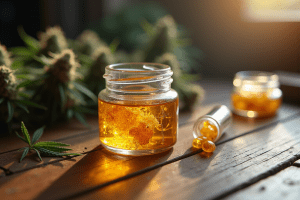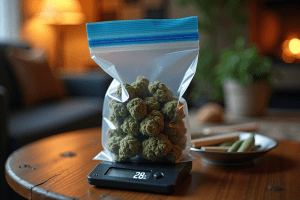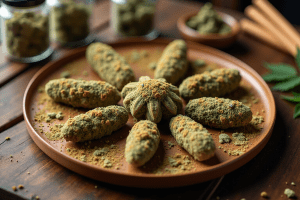Overview
This article delves into the identification and benefits of cannabis leaves, shedding light on the differences between fan and sugar structures. Understanding these differences is crucial as they play significant roles in plant health and culinary applications. By exploring how these leaf types contribute to photosynthesis, strain identification, and the enhancement of cannabis product quality, we can appreciate their importance even more.
Moreover, cannabis leaves offer potential health benefits in cooking, making them a valuable addition to our diets. Have you ever considered how these leaves could enrich your meals? By educating ourselves on their uses, we can make informed choices that benefit both our health and our culinary experiences.
Together, let’s embrace the knowledge of cannabis leaves and their diverse applications. By doing so, we not only enhance our understanding but also support our well-being. Explore the possibilities and discover how these remarkable leaves can positively impact your life.
Introduction
Cannabis leaves are so much more than a mere byproduct of the plant; they are vital components that play crucial roles in both cultivation and consumption. Have you ever considered how the broad, sun-catching fan leaves drive photosynthesis, or how the smaller, cannabinoid-rich sugar leaves contribute to the plant’s richness? Understanding these leaf types is essential for anyone interested in cannabis cultivation or products. This article invites you to explore the anatomy of cannabis leaves, delving into their unique structures, identifying features, and addressing common issues that can affect their health.
Moreover, we will highlight innovative culinary uses for these leaves, encouraging creativity in your kitchen. It’s important to underscore the role of consumer education in nurturing a responsible cannabis culture. As the cannabis industry continues to evolve, gaining deeper knowledge of these green wonders can empower both growers and consumers, ensuring a more fruitful and informed experience together.
Anatomy of Cannabis Leaves: Types and Structures
Cannabis foliage, particularly the weed leaf, can be understood through two distinct categories: fan structures and sugar structures. Each plays a vital role in the plant’s anatomy, contributing to its health and growth. Fan structures, characterized by their large, jagged edges, are crucial for photosynthesis, a process essential for the organism’s vitality. When light exposure is limited, photosynthesis decreases, which can reduce the carbon available for foliage structure. This limitation may significantly affect the plant’s overall vigor and yield.
The form and dimensions of fan foliage vary widely among different cannabis varieties. For instance, sativa foliage tends to be elongated and slim, while indica foliage is generally shorter and broader. This diversity not only reflects the genetic traits of each strain but also influences the plant’s overall health and adaptability.
On the other hand, sugar foliage, akin to a weed leaf, is smaller and located near the buds. These leaves are often adorned with a thick layer of trichomes, rich in cannabinoids and terpenes. These components are essential for producing the psychoactive and therapeutic substances that many consumers seek, whether for recreational or medicinal purposes. Understanding the structure of these weed leaves can provide valuable insights into the plant’s health and the quality of the final product.
The relationship between fan foliage and sugar foliage is also significant for cultivation practices. The calyx-to-foliage ratio, which describes the balance between bracts (the flowering parts) and sugar foliage, directly impacts bud development and quality. A higher ratio of calyxes to foliage typically indicates a more favorable yield, suggesting that the plant is directing its energy towards flower production rather than excessive greenery.
This connection is crucial for growers who aspire to optimize their harvests.
Recent research has explored how plant structure affects marijuana cultivation. For example, studies on blind breaking in marijuana trials revealed that prior marijuana use among patients did not notably influence treatment effectiveness or side effects. This finding suggests that physiological responses to marijuana may be consistent across different user backgrounds. Such discoveries underscore the importance of understanding plant structure within the broader context of marijuana research and application.
Expert insights further emphasize the significance of these plant types. Horticulturists note that the structure of the weed leaf is not only vital for photosynthesis but also for the plant’s ability to adapt to its environment. As Judyta Cielecka-Piontek from the Department of Pharmacognosy and Biomaterials at Poznan University of Medical Sciences remarked, “Among the tested conditions, ultrasound-assisted extraction using methanol yielded the highest cannabinoid profile,” highlighting the crucial role of plant structure in cannabinoid extraction.
Additionally, recent findings suggest that methanol Tygra foliage extract possesses notable antioxidant properties, further showcasing the benefits of marijuana foliage beyond their direct agricultural functions.
In conclusion, recognizing the differences between fan foliage and sugar foliage, along with their respective structures and functions, is essential for anyone looking to deepen their understanding of marijuana cultivation and enhance product quality. Together, we can explore these fascinating aspects of cannabis and make informed choices that benefit our cultivation practices.
Key Identifying Features of Cannabis Leaves
When it comes to identifying marijuana weed leaves, several key characteristics stand out, including the number of leaflets, color, and texture. These features are essential in recognizing different varieties. Typically, the leaves contain between 5 to 13 leaflets, and this count often signals the type of strain. For instance, sativa strains are known for their narrow and elongated leaves, while indica strains present broader and thicker foliage.
The color of marijuana leaves can range from light green to dark green. Healthy leaves usually exhibit a vibrant shade, which indicates that the plant is thriving under optimal conditions. The texture is equally important; healthy leaves should feel smooth and slightly waxy. If you notice any discoloration or roughness, it may be a sign of nutrient deficiencies or potential diseases affecting the plant.
Understanding these morphological traits is vital. Recent research highlights how they can guide cultivation methods and enhance the quality and potency of products derived from these leaves. Inflorescences were collected every two weeks during the 2-to-8-week period after the short-day photoperiod, providing insights into the timing of leaf development and its importance for identifying varieties. A detailed evaluation of flower and trichome traits, as outlined in the case study ‘Flower and Trichome Features Assessment,’ has revealed valuable connections between leaf characteristics and the quality of marijuana.
This knowledge is invaluable for both growers and consumers who wish to identify and select the best strains, particularly those with desirable leaf traits that meet their needs. In 2025, a comprehensive identification guide for weed leaves will further support cultivators and land managers by highlighting the key aspects that differentiate Cannabis sativa from similar species. As Zachary T. Brym, an assistant professor of agroecology, states, ‘The purpose of this document is to provide an identification guide for Cannabis sativa to be used by growers and land managers by showing key factors to distinguish it from similar-looking plants.’ This guide will emphasize the importance of the number, color, and texture of weed leaves in strain identification, empowering users to make informed decisions in their marijuana journey.
Moreover, ongoing research underscores the need for thorough studies on marijuana morphology. This knowledge not only informs cultivation methods but also deepens our understanding of its biology for both medicinal and industrial uses. Together, we can explore these insights and enhance our appreciation for the diverse world of marijuana.
Diagnosing Cannabis Leaf Problems: Symptoms and Solutions
Common symptoms of issues with weed leaves, such as yellowing, curling, and spotting, can be concerning for growers. Each of these signs indicates specific underlying problems that need attention. For instance, yellowing leaves often signal nutrient shortages, particularly nitrogen, which is vital for robust growth. Curling leaves may indicate overwatering or nutrient burn, both of which can stress the plant and hinder its development.
Brown spots, on the other hand, could suggest pest infestations or fungal infections, requiring immediate action to prevent further damage. To effectively address these challenges, it’s essential for growers to evaluate their watering practices and nutrient levels regularly. Routine inspections for pests and maintaining ideal growing conditions are crucial preventive measures. Have you considered using organic pesticides? They can effectively manage infestations while minimizing harm to your plants.
Recent research highlights that nutrient deficiencies are prevalent among marijuana cultivators, with studies revealing that improper nutrient management can lead to significant crop losses. A recent review underscored the importance of using certified pathogen-free planting material and biological control agents to reduce risks associated with common pathogens that affect marijuana crops. Additionally, electrobeam irradiation has been authorized in Canada for dried marijuana buds, significantly reducing populations of Penicillium spp. and Botrytis, which pose threats to plant health.
According to Z. K. Punja, a study published in the Canadian Journal of Plant Pathology found that the average HLVd infection rate was 25.6% in Canada. This statistic emphasizes the prevalence of pathogens affecting cannabis crops, including those impacting weed leaves, and highlights the importance of disease management. It’s crucial for growers to familiarize themselves with the symptoms of cannabis leaf issues. Agronomists recommend a proactive approach, involving soil testing and observing environmental conditions, to ensure crops receive the essential nutrients and care they need.
By understanding the causes of yellowing, curling, and spotting, we can implement targeted solutions that promote healthier plants and higher yields. It’s also important to recognize that marijuana is the most commonly used federally illegal drug in the United States, which adds complexity to its cultivation and management. Together, by staying informed and attentive, we can nurture our plants and foster a thriving growing community.
Creative Uses for Cannabis Leaves: Cooking, Tea, and More
Weed leaf opens up a world of imaginative cooking possibilities, serving as a wonderful gateway to understanding the broader benefits of marijuana, especially CBD. These vibrant greens can easily be added to smoothies for a nutritious boost or brewed in hot water to create a soothing herbal tea. For example, fresh weed leaf can be blended into pesto, adding a unique flavor, or used as a fresh herb in salads and various dishes.
Dried leaves can also be infused into oils or butters, allowing for delightful homemade edibles. This approach not only minimizes waste but also enhances the nutritional value of our meals.
Recent studies highlight the health benefits of weed leaf, rich in vitamins and antioxidants. One study on gluten-free biscuits found that incorporating hemp flour, derived from hemp plants, resulted in higher protein content and antioxidant activity compared to traditional corn flour biscuits. Although these biscuits turned out darker and denser, they showcased how marijuana can elevate food quality.
Culinary experts are increasingly embracing weed leaf, with many chefs advocating for its inclusion in modern cuisine. The versatility of these plants inspires creative recipes, from infused oils to refreshing teas. As the culinary world evolves, the innovative uses of weed leaf are gaining recognition, making it an exciting ingredient for both novice and experienced cooks alike.
Moreover, the potential health benefits of hemp foliage are underscored by the soothing effects of topical CBD products and hemp tinctures, which can provide significant relief for pain and discomfort. Many users report feeling ‘elevated’ and ‘naturally relaxed’ when using these products, enhancing their overall culinary journey. It’s also important for new cannabis users to understand that if a dog consumes sugary foliage, seeking veterinary assistance is crucial due to potential digestive issues.
The Role of Cannabis Leaves in Cultivation and Consumer Education
Weed leaf plays a vital role in both cultivation methods and consumer education. For growers, the condition of the weed leaf serves as a crucial indicator of the plant’s overall health. Changes in foliage color, texture, or size can signal the need for adjustments in nutrient supply or environmental factors, ensuring optimal growth.
Understanding this is essential, as healthy weed leaf directly contributes to a robust yield and the quality of the final product.
For consumers, grasping the significance of the weed leaf can deepen their appreciation for the products they choose. By informing consumers about various types of foliage, such as fan and sugar leaf varieties, and their specific roles, we empower them to make knowledgeable decisions when selecting strains or products. This awareness not only strengthens their connection to the plant but also encourages responsible consumption practices.
Recent statistics underscore the importance of consumer education in this area. Studies reveal that many marijuana users lack a thorough understanding of the plant’s structure, including the role of the weed leaf. Notably, 64.7% of 12th graders disapprove of adults smoking marijuana regularly, highlighting societal attitudes that emphasize the need for informed consumption.
At Leafy Mate, we are dedicated to bridging this knowledge gap by enhancing educational resources and focusing on the importance of weed leaf in cultivation. As the marijuana market continues to expand, with projected revenues reaching $45.3 billion by 2025, fostering informed consumers will be essential for promoting responsible use and appreciation of marijuana products.
Moreover, as marijuana legalization spreads—evidenced by Ukraine’s legalization of medicinal marijuana in February 2024—there is an increasing demand for accessible information that demystifies the plant. The decline in marijuana usage among 8th graders to 0.7% over the past five years, alongside evolving views on risk among 12th graders, highlights the critical role of education in responsible drug consumption. By prioritizing education on the weed leaf, Leafy Mate not only assists consumers in making informed choices about marijuana plants but also contributes to a more knowledgeable and responsible community.
Through our comprehensive platform, Leafy Mate provides dispensary recommendations, medical resources, and educational insights to help new cannabis consumers navigate their journey with confidence. We invite you to reach out to Leafy Mate for more information or to book a demo to explore our services further.
Conclusion
Understanding the anatomy and functions of cannabis leaves is essential for anyone involved in cannabis cultivation or consumption. This article has explored the distinct types of leaves—fan leaves and sugar leaves—highlighting their roles in photosynthesis, cannabinoid production, and overall plant health. Recognizing the structural differences and identifying features of these leaves, such as color and texture, can significantly enhance cultivation practices and product quality.
Furthermore, diagnosing common leaf problems and implementing effective solutions are crucial for maintaining healthy plants. Are you aware of symptoms like yellowing or curling leaves? Recognizing these signs allows growers to address nutrient deficiencies and environmental stresses promptly. This proactive approach can lead to improved yields and a better understanding of the challenges within cannabis cultivation.
The culinary potential of cannabis leaves also opens up exciting avenues for creative cooking and nutritional benefits. From enhancing smoothies to creating infused oils, the versatility of these leaves invites innovative uses that minimize waste and enrich meals. Coupled with the growing interest in the health benefits of cannabis, this knowledge empowers us to appreciate and responsibly engage with cannabis products.
Ultimately, as the cannabis industry continues to evolve, fostering consumer education about the significance of cannabis leaves is paramount. By bridging the knowledge gap and promoting informed consumption, we can contribute to a more responsible and enriched cannabis culture together. Embracing this understanding not only enhances our cultivation experience but also cultivates a deeper connection to the plant and its myriad benefits.
Frequently Asked Questions
What are the two main categories of cannabis foliage?
The two main categories of cannabis foliage are fan structures and sugar structures.
What is the role of fan structures in cannabis plants?
Fan structures are crucial for photosynthesis, which is essential for the plant’s vitality. They help in maximizing light exposure, and their size and shape can vary among different cannabis varieties.
How do the shapes of fan foliage differ between cannabis strains?
Sativa foliage tends to be elongated and slim, while indica foliage is generally shorter and broader, reflecting the genetic traits of each strain.
What are sugar structures in cannabis foliage?
Sugar structures are smaller leaves located near the buds, often covered in trichomes that are rich in cannabinoids and terpenes, which are important for the psychoactive and therapeutic properties of cannabis.
How does the calyx-to-foliage ratio affect cannabis cultivation?
The calyx-to-foliage ratio, which describes the balance between flowering parts (bracts) and sugar foliage, impacts bud development and quality. A higher ratio typically indicates better yield as the plant focuses energy on flower production.
What recent research findings relate to cannabis plant structure?
Recent studies indicated that prior marijuana use among patients did not significantly affect treatment outcomes, suggesting consistent physiological responses across different users, highlighting the importance of understanding plant structure.
Why is the structure of weed leaves important for cannabinoid extraction?
The structure of weed leaves is vital for both photosynthesis and the plant’s adaptability, which influences the cannabinoid profile during extraction processes, as noted in expert insights.
What key characteristics help identify marijuana weed leaves?
Key characteristics include the number of leaflets (typically between 5 to 13), color (ranging from light to dark green), and texture (healthy leaves feel smooth and slightly waxy).
How can the morphological traits of leaves guide cultivation methods?
Understanding the morphological traits can enhance the quality and potency of cannabis products, as well as assist in identifying different strains, particularly those with desirable leaf traits.
What future resources are being developed to assist in cannabis strain identification?
A comprehensive identification guide for weed leaves is set to be released in 2025, which will help growers and land managers distinguish Cannabis sativa from similar species based on key leaf characteristics.
Get Your Medical Card
Connect with a licensed physician online in minutes













